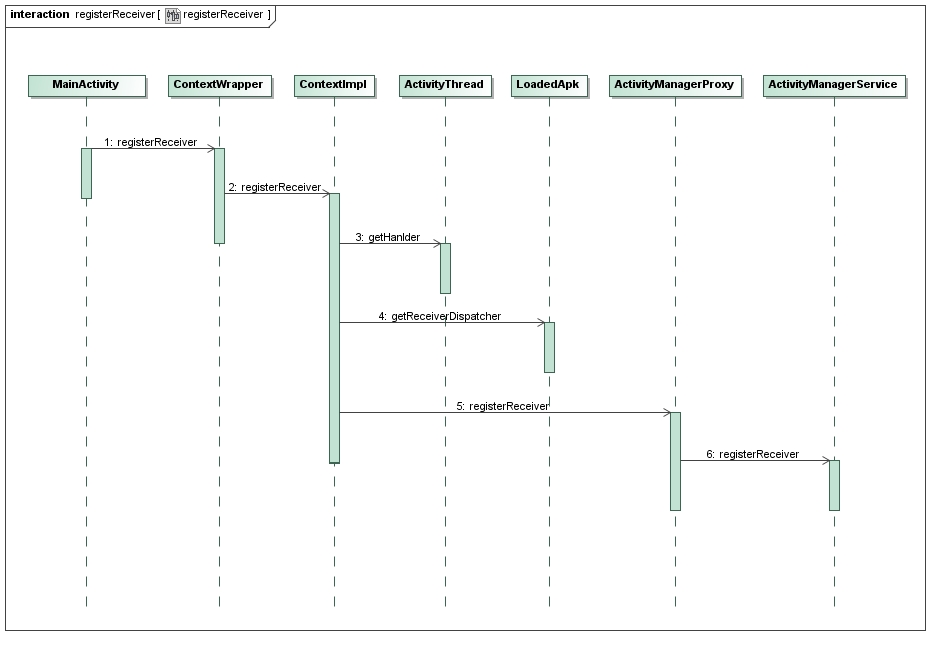Android应用程序注册广播接收器(registerReceiver)的过程分析
Android应用程序注册广播接收器(registerReceiver)的过程分析 - 老罗的Android之旅 - 博客频道 - CSDN.NET
?? ? ? ?前面我们介绍了Android系统的广播机制,从本质来说,它是一种消息订阅/发布机制,因此,使用这种消息驱动模型的第一步便是订阅消息;而对Android应用程序来说,订阅消息其实就是注册广播接收器,本文将探讨Android应用程序是如何注册广播接收器以及把广播接收器注册到哪里去的。
?? ? ? ?在Android的广播机制中,ActivityManagerService扮演着广播中心的角色,负责系统中所有广播的注册和发布操作,因此,Android应用程序注册广播接收器的过程就把是广播接收器注册到ActivityManagerService的过程。Android应用程序是通过调用ContextWrapper类的registerReceiver函数来把广播接收器BroadcastReceiver注册到ActivityManagerService中去的,而ContextWrapper类本身又借助ContextImpl类来注册广播接收器。
?? ? ? ?在Android应用程序框架中,Activity和Service类都继承了ContextWrapper类,因此,我们可以在Activity或者Service的子类中调用registerReceiver函数来注册广播接收器。Activity、Service、ContextWrapper和ContextImpl这四个类的关系可以参考前面Android系统在新进程中启动自定义服务过程(startService)的原理分析一文中描述的Activity类图。
?? ? ? ?这篇文章还是继续以实例来进行情景分析,所用到的例子便是上一篇文章Android系统中的广播(Broadcast)机制简要介绍和学习计划里面介绍的应用程序了,所以希望读者在继续阅读本文之前,先看看这篇文章;又由于Android应用程序是把广播接器注册到ActivityManagerService中去的,因此,这里又会涉入到Binder进程间通信机制,所以希望读者对Android系统的Binder进程间通信机制有所了解,具体请参考Android进程间通信(IPC)机制Binder简要介绍和学习计划一文。
?? ? ? ?开始进入主题了,在Android系统中的广播(Broadcast)机制简要介绍和学习计划一文所介绍的例子中,注册广播接收器的操作是MainActivity发起的,我们先来看看注册过程的序列图:
?? ? ? ?在分析这个序列图之前,我们先来看一下MainActivity是如何调用registerReceiver函数来注册广播接收器的:
- public?class?MainActivity?extends?Activity?implements?OnClickListener?{????
- ????......??
- ??
- ????@Override?????
- ????public?void?onResume()?{????
- ????????super.onResume();????
- ??
- ????????IntentFilter?counterActionFilter?=?new?IntentFilter(CounterService.BROADCAST_COUNTER_ACTION);????
- ????????registerReceiver(counterActionReceiver,?counterActionFilter);????
- ????}???
- ??
- ????......??
- ??
- }??
?? ? ? ?MainActivity在onResume函数里,通过其父类ContextWrapper的registerReceiver函数注册了一个BroadcastReceiver实例counterActionReceiver,并且通过IntentFilter实例counterActionFilter告诉ActivityManagerService,它要订阅的广播是CounterService.BROADCAST_COUNTER_ACTION类型的,这样,ActivityManagerService在收到CounterService.BROADCAST_COUNTER_ACTION类型的广播时,就会分发给counterActionReceiver实例的onReceive函数。
?? ? ? ?接下来,就开始分析注册过程中的每一个步骤了。
?? ? ? ?Step 1. ContextWrapper.registerReceiver
?? ? ? ?这个函数实现在frameworks/base/core/java/android/content/ContextWrapper.java文件中:
- public?class?ContextWrapper?extends?Context?{??
- ????Context?mBase;??
- ????......??
- ??
- ????@Override??
- ????public?Intent?registerReceiver(??
- ????????BroadcastReceiver?receiver,?IntentFilter?filter)?{??
- ????????return?mBase.registerReceiver(receiver,?filter);??
- ????}??
- ??
- ????......??
- ??
- }??
?? ? ? ?这里的成员变量mBase是一个ContextImpl实例,想知道为什么,可以回过头去看看Android应用程序启动过程源代码分析这篇文章>~<。
?? ? ? ?Step 2. ContextImpl.registerReceiver
?? ? ? ?这个函数实现在frameworks/base/core/java/android/app/ContextImpl.java文件中:
- class?ContextImpl?extends?Context?{??
- ????......??
- ??
- ????@Override??
- ????public?Intent?registerReceiver(BroadcastReceiver?receiver,?IntentFilter?filter)?{??
- ????????return?registerReceiver(receiver,?filter,?null,?null);??
- ????}??
- ??
- ????@Override??
- ????public?Intent?registerReceiver(BroadcastReceiver?receiver,?IntentFilter?filter,??
- ????????????String?broadcastPermission,?Handler?scheduler)?{??
- ????????return?registerReceiverInternal(receiver,?filter,?broadcastPermission,??
- ????????????scheduler,?getOuterContext());??
- ????}??
- ??
- ????private?Intent?registerReceiverInternal(BroadcastReceiver?receiver,??
- ????????????IntentFilter?filter,?String?broadcastPermission,??
- ????????????Handler?scheduler,?Context?context)?{??
- ????????IIntentReceiver?rd?=?null;??
- ????????if?(receiver?!=?null)?{??
- ????????????if?(mPackageInfo?!=?null?&&?context?!=?null)?{??
- ????????????????if?(scheduler?==?null)?{??
- ????????????????????scheduler?=?mMainThread.getHandler();??
- ????????????????}??
- ????????????????rd?=?mPackageInfo.getReceiverDispatcher(??
- ????????????????????receiver,?context,?scheduler,??
- ????????????????????mMainThread.getInstrumentation(),?true);??
- ????????????}?else?{??
- ????????????????......??
- ????????????}??
- ????????}??
- ????????try?{??
- ????????????return?ActivityManagerNative.getDefault().registerReceiver(??
- ????????????????????mMainThread.getApplicationThread(),??
- ????????????????????rd,?filter,?broadcastPermission);??
- ????????}?catch?(RemoteException?e)?{??
- ????????????????return?null;??
- ????????}??
- ????}??
- ??
- ????......??
- ??
- }??
?? ? ? ?通过两个函数的中转,最终就进入到ContextImpl.registerReceiverInternal这个函数来了。这里的成员变量mPackageInfo是一个LoadedApk实例,它是用来负责处理广播的接收的,在后面一篇文章讲到广播的发送时(sendBroadcast),会详细描述。参数broadcastPermission和scheduler都为null,而参数context是上面的函数通过调用函数getOuterContext得到的,这里它就是指向MainActivity了,因为MainActivity是继承于Context类的,因此,这里用Context类型来引用。
?? ? ? ?由于条件mPackageInfo != null和context != null都成立,而且条件scheduler == null也成立,于是就调用mMainThread.getHandler来获得一个Handler了,这个Hanlder是后面用来分发ActivityManagerService发送过的广播用的。这里的成员变量mMainThread是一个ActivityThread实例,在前面Android应用程序启动过程源代码分析这篇文章也描述过了。我们先来看看ActivityThread.getHandler函数的实现,然后再回过头来继续分析ContextImpl.registerReceiverInternal函数。
?? ? ? ?Step 3. ActivityThread.getHandler
?? ? ? ?这个函数实现在frameworks/base/core/java/android/app/ActivityThread.java文件中:
- public?final?class?ActivityThread?{??
- ????......??
- ??
- ????final?H?mH?=?new?H();??
- ??
- ????private?final?class?H?extends?Handler?{??
- ????????......??
- ??
- ????????public?void?handleMessage(Message?msg)?{??
- ????????????......??
- ??
- ????????????switch?(msg.what)?{??
- ????????????......??
- ????????????}??
- ??
- ????????????......??
- ????????}??
- ??
- ????????......??
- ??
- ????}??
- ??
- ????......??
- ??
- ????final?Handler?getHandler()?{??
- ????????return?mH;??
- ????}??
- ??
- ????......??
- ??
- }??
?? ? ? ?有了这个Handler之后,就可以分发消息给应用程序处理了。
?? ? ? ?再回到上一步的ContextImpl.registerReceiverInternal函数中,它通过mPackageInfo.getReceiverDispatcher函数获得一个IIntentReceiver接口对象rd,这是一个Binder对象,接下来会把它传给ActivityManagerService,ActivityManagerService在收到相应的广播时,就是通过这个Binder对象来通知MainActivity来接收的。
?? ? ? ?我们也是先来看一下mPackageInfo.getReceiverDispatcher函数的实现,然后再回过头来继续分析ContextImpl.registerReceiverInternal函数。
?? ? ? ?Step 4. LoadedApk.getReceiverDispatcher
?? ? ? ?这个函数实现在frameworks/base/core/java/android/app/LoadedApk.java文件中:
- final?class?LoadedApk?{??
- ????......??
- ??
- ????public?IIntentReceiver?getReceiverDispatcher(BroadcastReceiver?r,??
- ????????????Context?context,?Handler?handler,??
- ????????????Instrumentation?instrumentation,?boolean?registered)?{??
- ????????synchronized?(mReceivers)?{??
- ????????????LoadedApk.ReceiverDispatcher?rd?=?null;??
- ????????????HashMap<BroadcastReceiver,?LoadedApk.ReceiverDispatcher>?map?=?null;??
- ????????????if?(registered)?{??
- ????????????????map?=?mReceivers.get(context);??
- ????????????????if?(map?!=?null)?{??
- ????????????????????rd?=?map.get(r);??
- ????????????????}??
- ????????????}??
- ????????????if?(rd?==?null)?{??
- ????????????????rd?=?new?ReceiverDispatcher(r,?context,?handler,??
- ????????????????????instrumentation,?registered);??
- ????????????????if?(registered)?{??
- ????????????????????if?(map?==?null)?{??
- ????????????????????????map?=?new?HashMap<BroadcastReceiver,?LoadedApk.ReceiverDispatcher>();??
- ????????????????????????mReceivers.put(context,?map);??
- ????????????????????}??
- ????????????????????map.put(r,?rd);??
- ????????????????}??
- ????????????}?else?{??
- ????????????????rd.validate(context,?handler);??
- ????????????}??
- ????????????return?rd.getIIntentReceiver();??
- ????????}??
- ????}??
- ??
- ????......??
- ??
- ????static?final?class?ReceiverDispatcher?{??
- ??
- ????????final?static?class?InnerReceiver?extends?IIntentReceiver.Stub?{??
- ????????????final?WeakReference<LoadedApk.ReceiverDispatcher>?mDispatcher;??
- ????????????......??
- ??
- ????????????InnerReceiver(LoadedApk.ReceiverDispatcher?rd,?boolean?strong)?{??
- ????????????????mDispatcher?=?new?WeakReference<LoadedApk.ReceiverDispatcher>(rd);??
- ????????????????......??
- ????????????}??
- ??
- ????????????......??
- ????????}??
- ??
- ????????......??
- ??
- ????????final?IIntentReceiver.Stub?mIIntentReceiver;??
- ????????final?Handler?mActivityThread;??
- ??
- ????????......??
- ??
- ????????ReceiverDispatcher(BroadcastReceiver?receiver,?Context?context,??
- ????????????????Handler?activityThread,?Instrumentation?instrumentation,??
- ????????????????boolean?registered)?{??
- ????????????......??
- ??
- ????????????mIIntentReceiver?=?new?InnerReceiver(this,?!registered);??
- ????????????mActivityThread?=?activityThread;??
- ??????????????
- ????????????......??
- ????????}??
- ??
- ????????......??
- ??
- ????????IIntentReceiver?getIIntentReceiver()?{??
- ????????????return?mIIntentReceiver;??
- ????????}??
- ??
- ????}??
- ??
- ????......??
- ??
- }??
?? ? ? ?在LoadedApk.getReceiverDispatcher函数中,首先看一下参数r是不是已经有相应的ReceiverDispatcher存在了,如果有,就直接返回了,否则就新建一个ReceiverDispatcher,并且以r为Key值保在一个HashMap中,而这个HashMap以Context,这里即为MainActivity为Key值保存在LoadedApk的成员变量mReceivers中,这样,只要给定一个Activity和BroadcastReceiver,就可以查看LoadedApk里面是否已经存在相应的广播接收发布器ReceiverDispatcher了。
?? ? ? ?在新建广播接收发布器ReceiverDispatcher时,会在构造函数里面创建一个InnerReceiver实例,这是一个Binder对象,实现了IIntentReceiver接口,可以通过ReceiverDispatcher.getIIntentReceiver函数来获得,获得后就会把它传给ActivityManagerService,以便接收广播。在ReceiverDispatcher类的构造函数中,还会把传进来的Handle类型的参数activityThread保存下来,以便后面在分发广播的时候使用。
?? ? ? ?现在,再回到ContextImpl.registerReceiverInternal函数,在获得了IIntentReceiver类型的Binder对象后,就开始要把它注册到ActivityManagerService中去了。
?? ? ? ?Step 5. ActivityManagerProxy.registerReceiver
?? ? ? ?这个函数实现在frameworks/base/core/java/android/app/ActivityManagerNative.java文件中:
- class?ActivityManagerProxy?implements?IActivityManager??
- {??
- ????......??
- ??
- ????public?Intent?registerReceiver(IApplicationThread?caller,??
- ????????????IIntentReceiver?receiver,??
- ????????????IntentFilter?filter,?String?perm)?throws?RemoteException??
- ????{??
- ????????Parcel?data?=?Parcel.obtain();??
- ????????Parcel?reply?=?Parcel.obtain();??
- ????????data.writeInterfaceToken(IActivityManager.descriptor);??
- ????????data.writeStrongBinder(caller?!=?null???caller.asBinder()?:?null);??
- ????????data.writeStrongBinder(receiver?!=?null???receiver.asBinder()?:?null);??
- ????????filter.writeToParcel(data,?0);??
- ????????data.writeString(perm);??
- ????????mRemote.transact(REGISTER_RECEIVER_TRANSACTION,?data,?reply,?0);??
- ????????reply.readException();??
- ????????Intent?intent?=?null;??
- ????????int?haveIntent?=?reply.readInt();??
- ????????if?(haveIntent?!=?0)?{??
- ????????????intent?=?Intent.CREATOR.createFromParcel(reply);??
- ????????}??
- ????????reply.recycle();??
- ????????data.recycle();??
- ????????return?intent;??
- ????}??
- ??
- ????......??
- ??
- }??
?? ? ? ? 这个函数通过Binder驱动程序就进入到ActivityManagerService中的registerReceiver函数中去了。
?? ? ? ? Step 6. ActivityManagerService.registerReceiver
?? ? ? ? 这个函数实现在frameworks/base/services/java/com/android/server/am/ActivityManagerService.java文件中:
- public?final?class?ActivityManagerService?extends?ActivityManagerNative??
- ????????implements?Watchdog.Monitor,?BatteryStatsImpl.BatteryCallback?{??
- ????......??
- ??
- ????public?Intent?registerReceiver(IApplicationThread?caller,??
- ????????????IIntentReceiver?receiver,?IntentFilter?filter,?String?permission)?{??
- ????????synchronized(this)?{??
- ????????????ProcessRecord?callerApp?=?null;??
- ????????????if?(caller?!=?null)?{??
- ????????????????callerApp?=?getRecordForAppLocked(caller);??
- ????????????????if?(callerApp?==?null)?{??
- ????????????????????......??
- ????????????????}??
- ????????????}??
- ??
- ????????????List?allSticky?=?null;??
- ??
- ????????????//?Look?for?any?matching?sticky?broadcasts...??
- ????????????Iterator?actions?=?filter.actionsIterator();??
- ????????????if?(actions?!=?null)?{??
- ????????????????while?(actions.hasNext())?{??
- ????????????????????String?action?=?(String)actions.next();??
- ????????????????????allSticky?=?getStickiesLocked(action,?filter,?allSticky);??
- ????????????????}??
- ????????????}?else?{??
- ????????????????......??
- ????????????}??
- ??
- ????????????//?The?first?sticky?in?the?list?is?returned?directly?back?to??
- ????????????//?the?client.??
- ????????????Intent?sticky?=?allSticky?!=?null???(Intent)allSticky.get(0)?:?null;??
- ??
- ????????????......??
- ??
- ????????????if?(receiver?==?null)?{??
- ????????????????return?sticky;??
- ????????????}??
- ??
- ????????????ReceiverList?rl??
- ????????????????=?(ReceiverList)mRegisteredReceivers.get(receiver.asBinder());??
- ????????????if?(rl?==?null)?{??
- ????????????????rl?=?new?ReceiverList(this,?callerApp,??
- ????????????????????Binder.getCallingPid(),??
- ????????????????????Binder.getCallingUid(),?receiver);??
- ??
- ????????????????if?(rl.app?!=?null)?{??
- ????????????????????rl.app.receivers.add(rl);??
- ????????????????}?else?{??
- ????????????????????......??
- ????????????????}??
- ????????????????mRegisteredReceivers.put(receiver.asBinder(),?rl);??
- ????????????}??
- ??
- ????????????BroadcastFilter?bf?=?new?BroadcastFilter(filter,?rl,?permission);??
- ????????????rl.add(bf);??
- ????????????......??
- ????????????mReceiverResolver.addFilter(bf);??
- ??
- ????????????//?Enqueue?broadcasts?for?all?existing?stickies?that?match??
- ????????????//?this?filter.??
- ????????????if?(allSticky?!=?null)?{??
- ????????????????......??
- ????????????}??
- ??
- ????????????return?sticky;??
- ????????}??
- ????}??
- ??
- ????......??
- ??
- }??
?? ? ? ? 函数首先是获得调用registerReceiver函数的应用程序进程记录块:
- ???ProcessRecord?callerApp?=?null;??
- ???if?(caller?!=?null)?{??
- callerApp?=?getRecordForAppLocked(caller);??
- if?(callerApp?==?null)?{??
- ????......??
- ???????}??
- ???}??
?? ? ? ?这里得到的便是上一篇文章Android系统中的广播(Broadcast)机制简要介绍和学习计划里面介绍的应用程序Broadcast的进程记录块了,MainActivity就是在里面启动起来的。
?? ? ? ?
- ???List?allSticky?=?null;??
- ??
- ???//?Look?for?any?matching?sticky?broadcasts...??
- ???Iterator?actions?=?filter.actionsIterator();??
- ???if?(actions?!=?null)?{??
- while?(actions.hasNext())?{??
- ????String?action?=?(String)actions.next();??
- ????allSticky?=?getStickiesLocked(action,?filter,?allSticky);??
- }??
- ???}?else?{??
- ......??
- ???}??
- ??
- ???//?The?first?sticky?in?the?list?is?returned?directly?back?to??
- ???//?the?client.??
- ???Intent?sticky?=?allSticky?!=?null???(Intent)allSticky.get(0)?:?null;??
?? ? ? ?这里传进来的filter只有一个action,就是前面描述的CounterService.BROADCAST_COUNTER_ACTION了,这里先通过getStickiesLocked函数查找一下有没有对应的sticky intent列表存在。什么是Sticky Intent呢?我们在最后一次调用sendStickyBroadcast函数来发送某个Action类型的广播时,系统会把代表这个广播的Intent保存下来,这样,后来调用registerReceiver来注册相同Action类型的广播接收器,就会得到这个最后发出的广播。这就是为什么叫做Sticky Intent了,这个最后发出的广播虽然被处理完了,但是仍然被粘住在ActivityManagerService中,以便下一个注册相应Action类型的广播接收器还能继承处理。
?? ? ? ?这里,假设我们不使用sendStickyBroadcast来发送CounterService.BROADCAST_COUNTER_ACTION类型的广播,于是,这里得到的allSticky和sticky都为null了。
?? ? ? ?继续往下看,这里传进来的receiver不为null,于是,继续往下执行:
- ???ReceiverList?rl??
- =?(ReceiverList)mRegisteredReceivers.get(receiver.asBinder());??
- ???if?(rl?==?null)?{??
- rl?=?new?ReceiverList(this,?callerApp,??
- ????Binder.getCallingPid(),??
- ????Binder.getCallingUid(),?receiver);??
- ??
- if?(rl.app?!=?null)?{??
- ????rl.app.receivers.add(rl);??
- }?else?{??
- ????......??
- }??
- mRegisteredReceivers.put(receiver.asBinder(),?rl);??
- ???}??
?? ? ? ?这里其实就是把广播接收器receiver保存一个ReceiverList列表中,这个列表的宿主进程是rl.app,这里就是MainActivity所在的进程了,在ActivityManagerService中,用一个进程记录块来表示这个应用程序进程,它里面有一个列表receivers,专门用来保存这个进程注册的广播接收器。接着,又把这个ReceiverList列表以receiver为Key值保存在ActivityManagerService的成员变量mRegisteredReceivers中,这些都是为了方便在收到广播时,快速找到对应的广播接收器的。
?? ? ? ?再往下看:
- BroadcastFilter?bf?=?new?BroadcastFilter(filter,?rl,?permission);??
- rl.add(bf);??
- ......??
- mReceiverResolver.addFilter(bf);??
?? ? ? ?上面只是把广播接收器receiver保存起来了,但是还没有把它和filter关联起来,这里就创建一个BroadcastFilter来把广播接收器列表rl和filter关联起来,然后保存在ActivityManagerService中的成员变量mReceiverResolver中去。
?? ? ? ?这样,广播接收器注册的过程就介绍完了,比较简单,但是工作又比较琐碎,主要就是将广播接收器receiver及其要接收的广播类型filter保存在ActivityManagerService中,以便以后能够接收到相应的广播并进行处理,在下一篇文章,我们将详细分析这个过程,敬请关注。
郑重声明:本站内容如果来自互联网及其他传播媒体,其版权均属原媒体及文章作者所有。转载目的在于传递更多信息及用于网络分享,并不代表本站赞同其观点和对其真实性负责,也不构成任何其他建议。




































